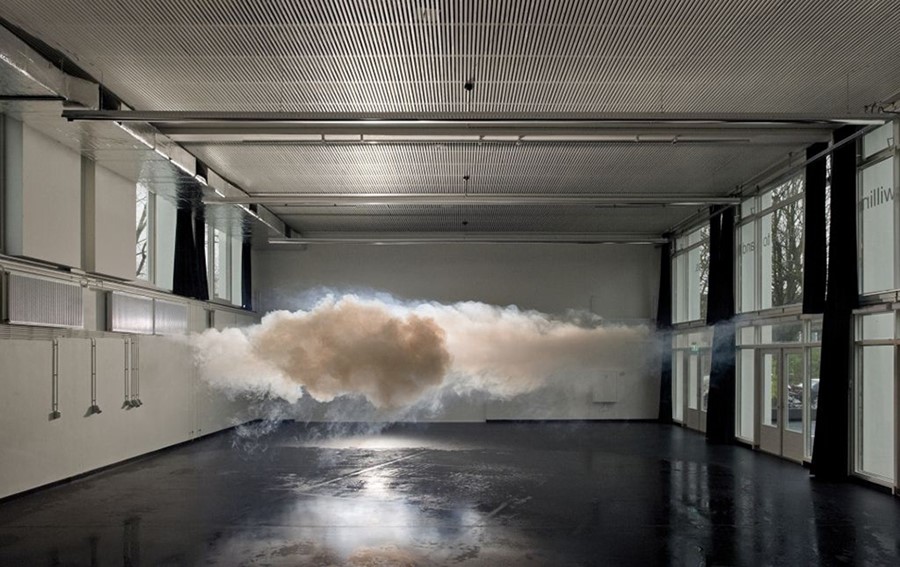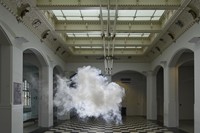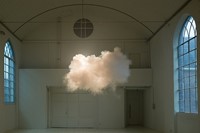Following the beautiful "sky moment" in London this morning, our attention turns to an exhibition opening next week featuring images of clouds floating in empty rooms by Berndnaut Smilde....
Following the beautiful "sky moment" in London this morning, our attention turns to an exhibition opening at the Ronchini Gallery next week featuring images of clouds floating in empty rooms. Eerie and bemusing, ephemeral and beautiful, demanding a closer look, the photographs form part of a double handed exhibition titled The Uncanny – a title taken from Sigmund Freud's 1919 essay of the same name – featuring works that provoke questions through their positioning of the banal into unlikely and unconventional situations.
The artist responsible is Berndnaut Smilde, who creates the fleeting puffs of vapour using a fog machine and aerogel, the lightest substance on earth. Within exacting conditions of precise temperature and humidity, the clouds take shape for just a matter of seconds before evaporating, a moment in time that Smilde captures on camera. The results are ravishingly strange images that hover, like the cloud itself, between the prosaic and the mythical, bridging the gap of scientific precision and the beauty of nature itself.
On the eve of the exhibition’s opening, AnOther spoke to Smilde, discussing the project's inception, and the relationship between the banal and the extraordinary.
What inspired you to create your Nimbus works?
The first Nimbus I made was in a small scale project space called Probe and was a project by the artist collective Suze May Sho. Probe is an exhibition space with walls no higher then 1,10m. It’s a test lab, an artistic skinner box. It's small and the practical dimensions of it enable artists to create works on a scale that is unthinkable in real life. Because you have total control over the space, it enables you to create an ideal situation. This is one of the reasons I think a model can stand for an idea. I transformed the exhibition space into my idea of a museum hall in which I wanted to present an ominous situation.
"The results are ravishingly strange images that hover, like the cloud itself, between the prosaic and the mythical, bridging the gap of scientific precision and the beauty of nature itself"
Did you create the system for making the clouds through extensive experimentation, or did you have help? How do you find that lengthy process that ends with such a short moment of creation?
Eventually I simply started experimenting with smoke because of the visual resemblance. By trying and testing with temperatures and moisture I got the hang of it. It’s not a high tech process at all. I can control the space, but the clouds will be different every time. It always takes a while to get them where I want. I like their short presence. It is just there for a few seconds, and then it falls apart.
Your cloud works are ephemeral, with their brief existence remembered and memorialised in a photograph. Do you consider that the artwork really exists solely in the second that it was real, or does it continue on in the images that remain?
The physical aspect is important but the work exists in the form of a photograph. The photo functions as a document of that short moment of presence that happened in a specific location. The work is about the idea of a cloud inside a space.
I've read that your passion is for the in-between, the transitional, creating a brief glimpse of something that subsequently, and almost immediately, vanishes. Are clouds in themselves a long time passion, or did you choose to create them as they are perfect manifestations of this notion of passing existence?
I often work with situations that deal with duality. They question construction and deconstruction, inside and outside, size, temporality, the function of materials and architectural elements. I find it interesting when a work functions in-between reality and representation in a way that it has potential but will never really function. Eventually it is determined fail but for a very brief moment you transport the image of a cloud inside a space and start making new connections. It also questions if a sculpture could exist of just well exposed air.
"I find it interesting when a work functions in-between reality and representation in the sense that it has potential but will never really function"
This exhibition is titled The Uncanny, and your works are strange as well as incredibly beautiful. Clouds in rooms is an alien, dreamlike concept - was this oddness a key element of their inception as an idea? Do you feel it is important for art to have a strangeness in order to capture the imagination?
Presenting a cloud out of its natural context opens the possibility to project lots of ideas on it. Clouds have always had loads of interpretations, we just don't want to be bothered by them everyday. I think it is the way artists work: they shuffle our furniture around and create a space with a different order.
You have also said that you wanted them to be almost cartoonish and clichéd - like the bulbous cloud that hangs over the head of the furious cartoon character - how do you marry the notions of the sinister and the cartoon together, if at all? Is it more that these pieces can be read differently by those who see them, or considering their location?
I'm really after an iconic looking cloud. I meant it to be like a cartoon visualisation of having bad luck, as if it could start raining on you or something that was there and had just vanished. You could see the cloud as a sign of misfortune or as an element out of a classical painting. I want people to have their own ideas about them. The locations do have influence on the context of the work. The spaces I work in are all in some way connected to exhibition spaces and therefore they question the artwork itself as well. The architecture in Nimbus D’aspremont plays an important role, where there is the contrast between the original castle and its former use as a military hospital and mental institution which is still visible. You could say the spaces function as a plinth for the work.
The Uncanny is at the Ronchini Gallery, London from January 16 – February 16.



